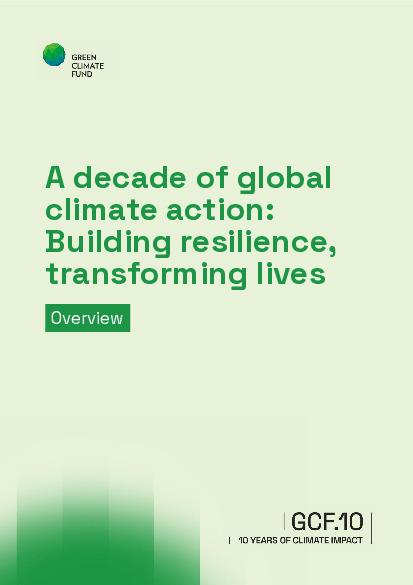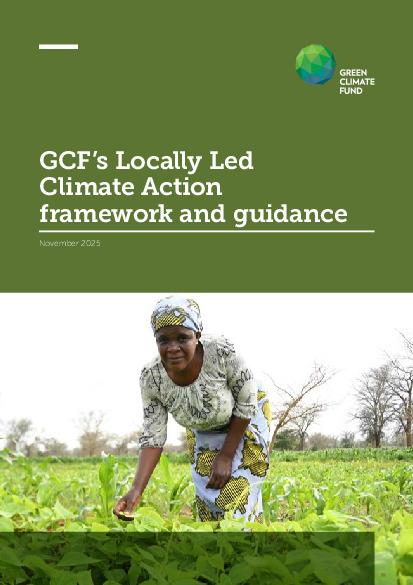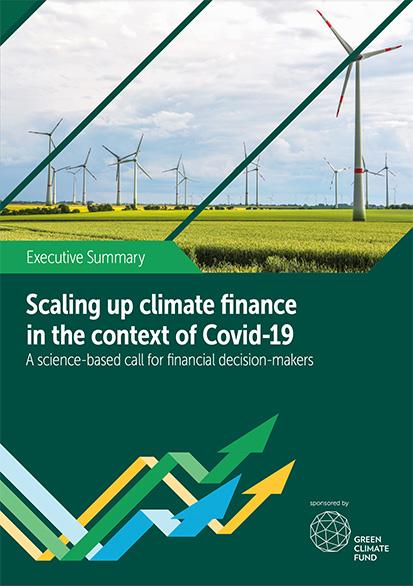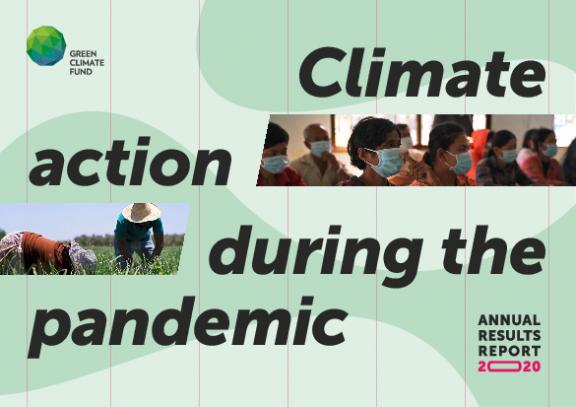Publications
The Green Climate Fund issues a range of publications for our direct and indirect stakeholders on a diversity of issues – for the general public to industry experts. Stay in tune with our mission and activities around the planet with the issues that speak to you.
Featured publications
GCF.10 Impact Report: Overview
A decade of global climate action: Building resilience, transforming lives
Read moreGCF’s Locally Led Climate Action framework and guidance
This document elaborates guidance on advancing good locally led practices through GCF modalities. Part 1 introduces GCF’s parameters and approach to devolution in the GCF business model and elaborates approaches for context-specific models. Part 2 provides step-by-step guidance for developing and structuring funding proposals in alignment with the parameters. A set of annexes cover Readiness, local, traditional and Indigenous knowledge, a related checklist and relevant examples from GCF portfolio.
Read moreCountry platforms for climate finance
This brochure describes GCF’s approach to country platforms, including an overview of the concept, the potential impact and the end-to-end support GCF can provide.
Read moreClimate investment planning and mobilization framework
The Green Climate Fund (GCF) and the NDC Partnership proudly launched the Climate Investment Planning and Mobilization Framework (Framework) to support countries in achieving national climate action. It aims to provide a common reference point fo
Read moreAnnual Progress Report 2024
This report describes the progress made by GCF to accelerate climate action for and by developing countries.
Read more
Thematic brief: Climate resilient infrastructure
August 2021
Infrastructure is key to many sectors including transportation, telecommunications, water, and energy, and it plays an important role within agriculture and health. Strong interdependencies mean that damages to a single infrastructure asset may cause a ‘domino effect’ of failures across systems. These damages have increasingly been caused by more extreme weather events linked to climate change – leading to billions of dollars of repair, loss of life and security for millions of people around...

Thematic brief: Forests and land use
May 2021
Forests are crucial for reducing greenhouse gas emissions and enhancing climate change adaptation. Healthy forests are more resilient to climate impacts. However, forest cover loss continues rapidly, contributing approximately 13 per cent of annual global net carbon emissions, mostly related to tropical deforestation and unsustainable forest management. Financing forest conservation and restoration is difficult because many forest benefits are not monetized. Financial incentives of activities...

Thematic brief: Ecosystems & ecosystem services
May 2021
Ecosystems consist of plants, animal and microorganism communities (including for example, rainforests, coral reefs, agricultural land and managed forests), while ecosystem goods and services are the benefits to human society that ecosystems provide (for example, water provision and flood and storm protection). Ecosystem degradation and the impacts of climate change release the carbon that is stored in biomass and soils, and increase the risk of ecological collapse. Land-use change,...

Scaling up climate finance in the context of Covid-19: Full report
May 2021
This report aims to help financial decision-makers to align finance with sustainable development, accelerating the transition to a net-zero, climate resilient economy, based on the latest scientific findings and policy developments. It proposes four interventions to achieve this objective in the context of Covid-19.

Thematic brief: Renewable energy
April 2021
The energy sector is one of the largest contributors to greenhouse gas emissions given the world’s reliance on fossil fuels. At the same time, hundreds of millions of people still lack access to electricity, and a third of the world’s population lack access to clean energy sources for cooking. According to the International Panel on Climate Change (IPCC), this means that renewable energy must supply 70 to 85 per cent of all electricity by 2050 for the world to meet the goals of the Paris...

GCF's digital agenda: a briefing
March 2021
In order to deliver on the GCF-1 ambitions, the Secretariat has prioritized becoming a fully digital organization. It has developed the GCF Digital Agenda: 2020 – 2023, which has four objectives: Increase operational efficiency to improve speed of delivery Enhance transparency and accountability Improve GCF’s capacity to actively identify and manage risks Reduce workload and create a safe, innovative and flexible workplace In order to achieve these objectives, the Digital Agenda has...

Country programme guidance
January 2021
Green Climate Fund (GCF) Country Programmes are the cornerstone of each country’s pipeline development with GCF. It is the first stage of the updated GCF project and programme cycle, and forms the basis for prioritising the further development of funding proposals for projects and programmes submitted by Accredited Entities on behalf of countries for funding. Countries are encouraged to develop a GCF Country Programme to drive their project and programme pipelines with GCF, and countries may...

The Green Climate Fund and the International Development Finance Club: A strategic alliance to realize the full potential of public development banks in financing the green and climate-resilient transition
November 2020
In the current pandemic we are facing, Public Development Banks are repositioning their role in driving climate ambition and building momentum in the lead up to COP 26. The IDFC, a group of 26 national and regional PDBs worldwide committed to aligning their activities with the Paris agreement, and GCF, set up by the UN to help developing countries combat climate change, have formed a strategic alliance to help PDBs finance a green and climate resilient transition. This joint working paper...

GCF in Brief: The Green Climate Fund: Realising the Climate Potential of Public Development Banks
November 2020
The Green Climate Fund is working to realise the potential of Public Development Banks to finance the green and climate-resilient transition. Ahead of the first ever gathering of 450+ public development banks for the Financing in Common Summit from 9-11 November, this factsheet sets out how GCF is partnering with PDBs around the world to drive the financial transition that the world needs to reach its climate goals.

Project Preparation Facility Guidelines
October 2020
GCF's Project Preparation Facility (PPF) provides financial support to Accredited Entities (AE) in preparing funding proposals for submission to the Green Climate Fund (GCF). The PPF supports AEs in preparing full Funding Proposals for consideration by the Board, based on a Concept Note that has been cleared for project preparation support vis-àvis GCF investment criteria. This publication provides practical guidelines to help AEs in preparing and submitting PPF requests to the GCF secretariat.

Tipping or turning point: Scaling up climate finance in the era of COVID-19
October 2020
The Covid-19 pandemic has brought the world to a tipping point or a turning point in the fight against climate change. Decisions taken by leaders today to revive economies will either entrench our dependence on fossil fuels or put us on a path to achieve the Paris Agreement and the Sustainable Development Goals (SDGs). For the COVID-19 pandemic to prove a turning point, climate action and COVID-19 economic stimulus measures must be mutually supportive; and developing countries must be able to...

Enhancing access to climate finance through readiness support
September 2020
The Green Climate Fund (GCF) and the Global Green Growth Institute (GGGI) are capitalising on their shared ability to help developing countries take climate action. Nowhere is this clearer than in GGGI’s role as a major delivery partner of grant funds from GCF’s Readiness and Preparatory Support Programme (the Readiness Programme) – designed to widen the scope of climate-focused financial resources for developing countries. GCF’s Readiness Programme is particularly well suited to help bolster...

Acumen Resilient Agriculture Fund: at a glance
July 2020
While the private sector plays an increasingly important role in renewable energy markets, there is a dearth of business support for climate adaptation, especially for smallholder farmers who bear the brunt of global warming. The innovative Acumen Resilient Agriculture Fund (ARAF) project draws in private sector investment to help small- scale farmers adapt, made possible by GCF’s anchor investment. This case study for FP078: Acumen Resilient Agriculture Fund provides an overview of the...

Bhutan for life: at a glance
July 2020
GCF joined the World Wildlife Fund (WWF), the Royal Government of Bhutan and other partners to create the Bhutan for Life project, which was approved in 2017. At the heart of this conservation effort is an innovative financial structure to permanently protect Bhutan’s network of Protected Areas. This case study for FP050: Bhutan for Life provides an overview of the project, expected results and impacts, as well as GCF's unique and innovative role.

GCF Programming Manual: An introduction to the Green Climate Fund project cycle and project development tools for full-size projects
July 2020
This document is no longer available The GCF Programming Manual, the Appraisal Guidance along with some of its annexes have been removed from circulation. Updated guidance on Concept Notes and Funding Proposals is currently under development and will be provided when complete.

Report on the progress of the Green Climate Fund during its initial resource mobilization period (January 2015 through March 2020)
April 2020
The Green Climate Fund is a unique institution. It is the manifestation of a joint global commitment to fight climate change and a crucial element of the Paris Agreement. Over the past five years, it has developed from an idea of solidarity between developed and developing countries to a crucial force in countering climate change and its effects. Over the past five years, GCF has committed over USD 5.6 billion of its own investment to support 129 projects in 108 countries and delivered more...

Synergies between climate finance mechanisms
April 2020
Collaboration between climate finance funds can enhance countries' resources and results. A report jointly commissioned by the Green Climate Fund (GCF) and the Climate Investment Funds (CIF) shows that country-driven coordination and collaboration between funds in blending finance can lead to better development outcomes, enhanced efficiency, and increased financing in developing countries. The study, "Synergies Between Climate Finance Mechanisms," is the result of a multilevel analysis of...

The Green Climate Fund’s Private Sector Facility
October 2019
GCF has a Private Sector Facility (PSF), with the primary mission to engage both the local and global private sector to support climate change mitigation and adaptation projects in developing countries. This brochure provides an overview of the PSF.







